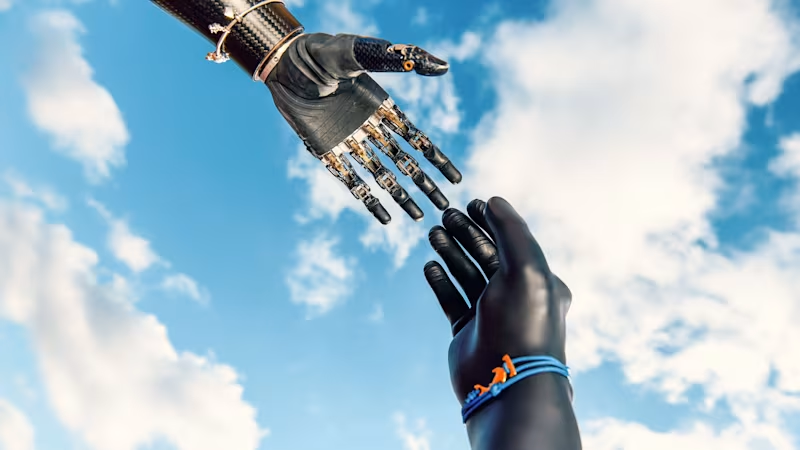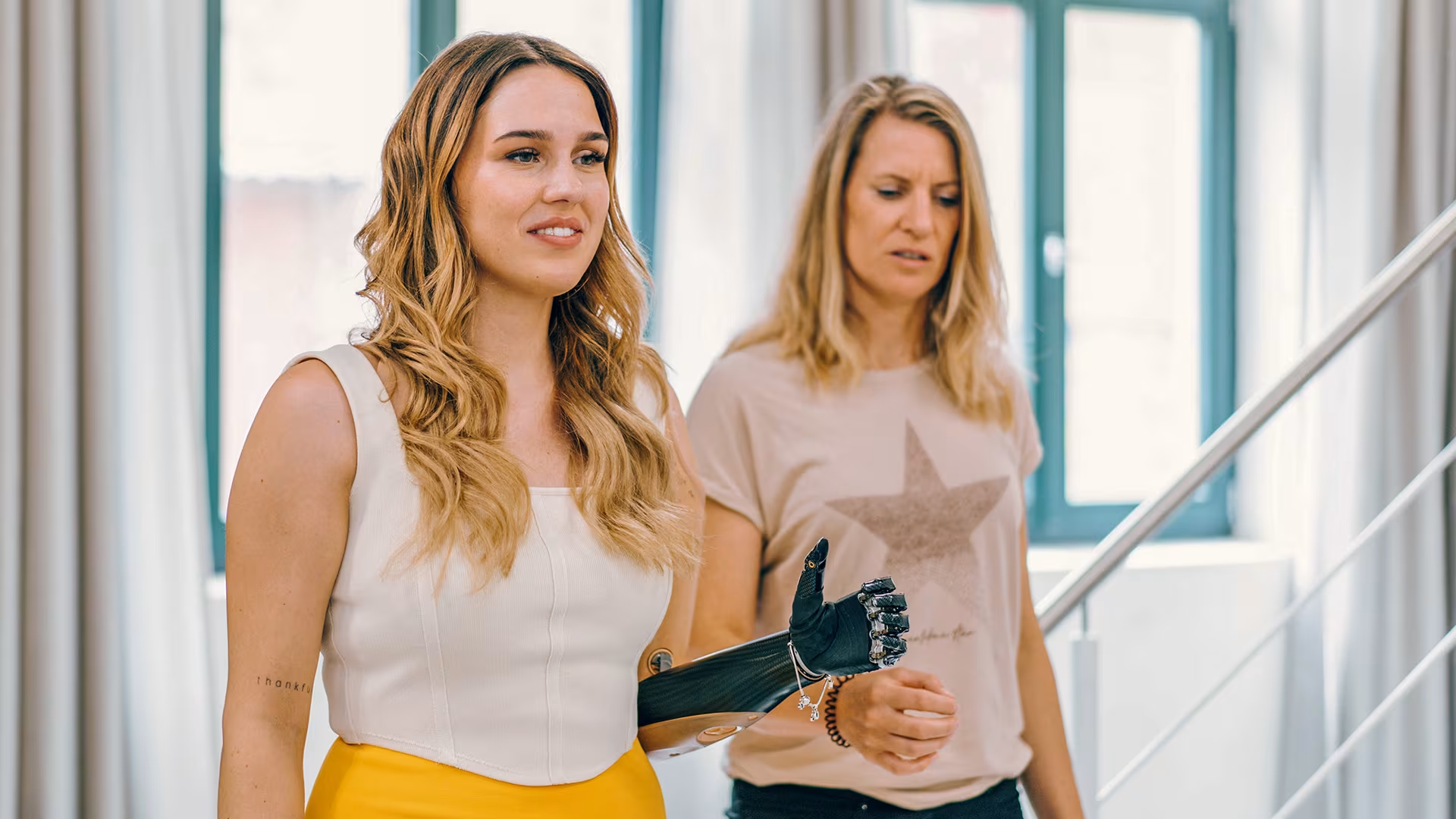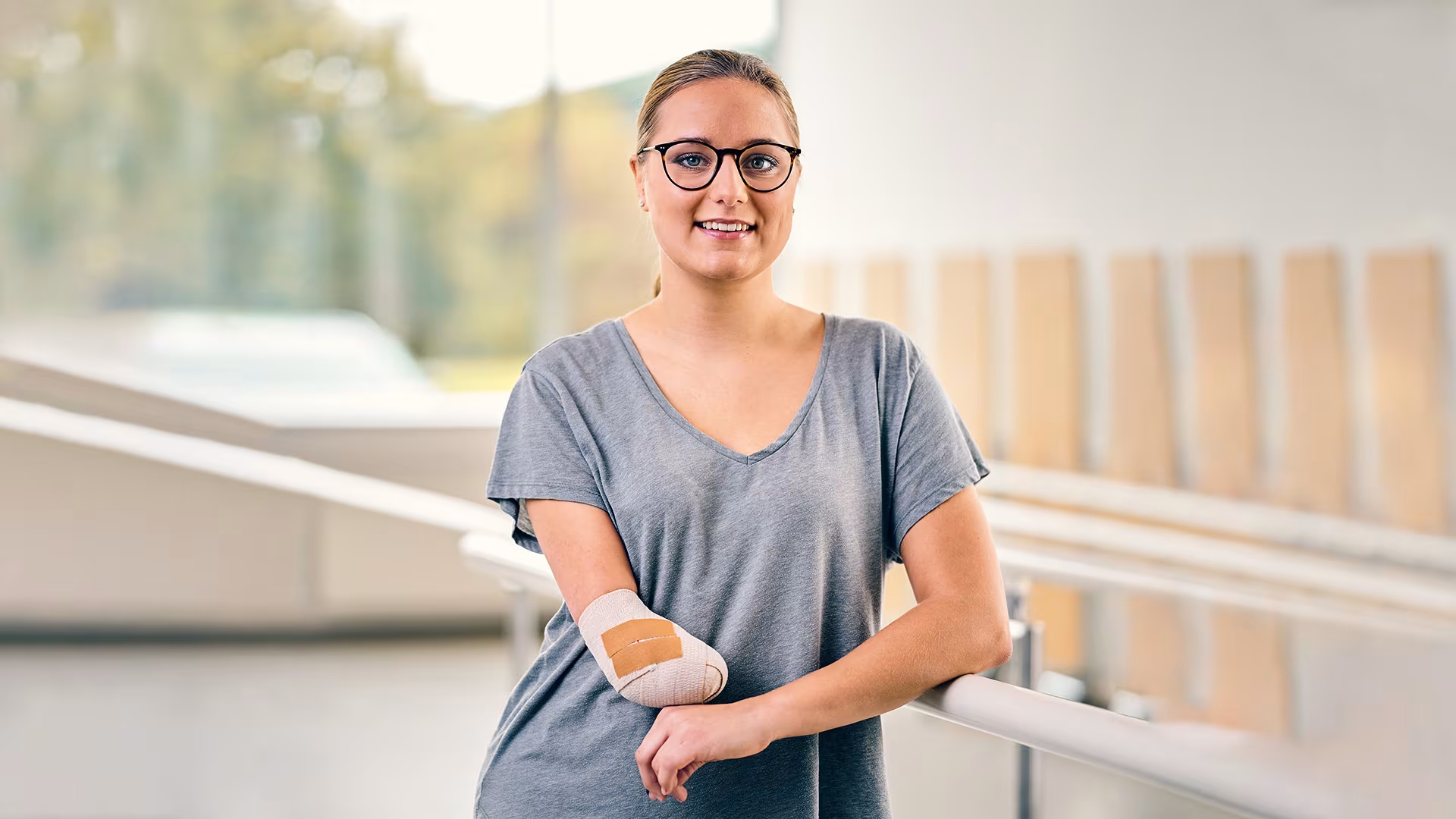


Learning to use a prosthetic arm
A prosthetic arm can make a big difference in your day-to-day life, but learning to use one can take lots of practice. Find out how to pick the right device and get the most from it.
A prosthetic arm can make a big difference in your day-to-day life, but learning to use one can take lots of practice. Find out how to pick the right device and get the most from it.
Mastering your prosthetic arm is a process.
Once your amputation surgery is complete and you begin the rehabilitation process, your care team will also help you prepare for another important step in your life after amputation: learning how to select and use a prosthetic.
Today, people with upper limb differences have many different kinds of prosthetic arms to choose from, if they decide to use one. While none of these devices can fully replace your hand or arm, the right one can be a valuable tool – one that helps make many activities, hobbies, and tasks much easier for you.
But like any tool that’s new to you, learning to use a prosthetic hand takes time, practice, and dedication. This article covers a few important topics to focus on when you’re just getting started:
The different kinds of prosthetic hands your prosthetist may discuss with you
How your prosthetist will customize your new device for your residual limb
Daily activities that can help you get the most from your prosthetic arm
Selecting the right device for you
If you decide you want to try a prosthetic arm, a professional prosthetist on your care team will help you explore the different options you can choose from and understand which one is best for you.
There are several different types of prosthetic arm you can try. Each one has different advantages, so it’s important to talk to your prosthetist about which of these devices will be the best fit for your lifestyle, hobbies, and job.
Some of the most popular kinds of prosthetic hand include:
Multiarticulating hands: These state-of-the-art devices use electrical signals from the muscles in your residual limb (“myoelectric” signals) to move the mechanical fingers and/or thumb in a way that mimics the human hand. The bebionic hand and Michelangelo hand are good examples.
VariPlus hands: These myoelectric devices give the user precise, open-and-close control of their prosthetic hand. Simple, durable options like the MyoHand VariPlus Speed and Greifer DMC VariPlus are often good “starter hands” for people who are new to prosthetic arms.
Body-powered prosthetics: These devices typically enable users to open and close a simple hook by using a harness and cable connected to their upper arm, shoulder and chest. These rugged, durable prosthetics can be a good choice for people who perform many heavy-duty activities.
Which one is the right choice for you? That’s an important discussion to have with your prosthetist. They’ll help you understand the advantages and limitations of each device, and which one will be the best fit for your daily life.
Natural vs “bionic”: How do you want your prosthetic arm to look?
This is an important question to ask yourself as you consider your options. Some people with an upper limb difference want their prosthetic to look as much like a “normal” arm as possible. Others love to show off their techy “bionic hand.”
You get to choose what’s most comfortable for you. If you want your prosthetic to look natural, most devices can be covered a “glove” (like the MyoSkin Natural) that’s customized to look like your hand. If you have a higher amputation level, you can also get natural-looking silicon prosthetics that mimic the look of your arm.
Love how cool your bebionic looks? Show it off!
Crafting the perfect connection between you and your device
Once you’ve chosen a device, your prosthetist will start working on one of the most important parts of your prosthetic arm: the socket that connects the device to your residual limb.
Your socket will be carefully customized just for you, using detailed measurements and models of your residual limb. This helps ensure your prosthetic will be comfortable, easy to move, and stay securely connected to your arm.
The customization process may require a couple of visits to your prosthetist’s office. But once it’s finished, your prosthetic should feel like you can easily wear it all day long.

MyoTest: Getting ready for a myoelectric prosthetic
If you’re interested in using a modern prosthetic like bebionic or Michelangelo, your fitting process will also include some steps to determine the best way to connect your device to the muscles that will power and control it.
To prep your socket for one of these devices, your prosthetist will perform a MyoTest: a series of measurements that help them verify that your residual limb is compatible with a myoelectric device, and then identify the best placement for your prosthetic’s electrodes.
If your residual limb is a good fit for a myoelectric prosthesis, your prosthetist will then use your MyoTest results to craft a socket that helps give you consistent, comfortable control of your myoelectric device.
Learning how to get the most from your prosthetic
Once your prosthetic is complete and ready to wear, your prosthetist will show you how to start using it. This training will usually focus on mastering basic movements, key grips, and everyday task you need to know how to manage.
Once you’re home, though, the real learning process starts.
Getting started with your device
When you’re just starting to use a prosthetic arm, don’t worry if some movements and activities are difficult for you. Remember: you’re relearning how to do a lot of things with a tool instead of your hand. It will take time, but if you keep practicing you’ll get more confident and capable every day!
Here are a few useful tips and tricks to help you build this important new skill.
Start simple and easy: As your prosthetist will tell you, mastering the basic functions of your new hand is the most important first step. Depending on your prosthetic arm, that may include opening and closing the hand, rotating the wrist, and flexing and stretching the elbow joint.
Practice these simple movements until you feel comfortable with them. Doing so will help you build up new skills, strengths, and instincts that will prepare you for more challenging movements and activities later on.
Start by practicing with simple, lightweight objects that are easy to grasp (and won’t break if you drop them!): a tennis ball, shoes, a remote control, or a cup. Once you can confidently pick them up, turn them over, and put them down, you’ll be ready to try some more advanced activities.
Use the 5-try rule: Any time you’re learning a complex new skill, practicing it repeatedly can get frustrating after a while – and that feeling can make it harder to come back and try again later.
When you’re working on any new prosthetic arm skill, don’t keep pushing until you’ve perfected it. Give yourself lots of physical AND mental breaks. A good rule: whatever it is, try it 5 times, and if you haven’t got it, come back and try again later.
Train every day: Like any new skill, learning to use a prosthetic arm takes dedication and consistency. Try to use your prosthetic every day, even if it’s just for a few hours at a time to start.
During the fitting process, your prosthetist will also give you some exercises tailored to your amputation and device. Take the time to do them every day. The more you do, the quicker you’ll achieve the control you need to get back to activities you love.

Building up to bigger challenges
Once you’ve confidently mastered basic movements and simple tasks, you’ll be ready for more complex movements and activities. Take the same smart approach: practice every single day, but always give yourself breaks to rest and reset between tries.
Here are a few good activities that can help you practice combining a few simple skills:
Folding towels or laundry
Getting dressed or undressed
Opening bottles, jars, or other containers
Using a knife and fork
When you first try out these more complicated activities, keep in mind that losing a hand or arm will also affect your balance and coordination. Your prosthetic arm won’t give you the same instinctive feedback about where it is, what it’s doing, and where it may guide the rest of your body. Practicing hand-eye coordination with your device is an important part of learning how to use it safely and successfully.
As you develop your skills, talk to your prosthetist about ways you can train yourself to “feel” what your prosthetic is doing as you use it.

Putting on and taking off your device
The skills you need for these steps will be different depending on:
The type of prosthetic you choose
The shape and size of your residual limb
Whether you’ve lost one or both upper limbs
Your prosthetist will give you detailed training on the best way for you to put on or take off your device(s). Make sure you feel comfortable and confident with these steps before you head home with your prosthetic!
If you decide to use a myoelectric device, make sure you slightly moisten the skin of your residual limb where it comes in contact with the electrodes in your socket. This will make it easier for nerve signals to travel from your muscles to the motors that power your device. If your skin is dry when you put on your prosthetic, it may take a moment before you have full control again.

Care and cleaning
Just like your natural hand, your prosthetic arm works hard every day – so it needs the same kind of consistent daily cleaning.
A few important things to remember:
Regularly wipe the inner socket with a damp cloth to remove any remaining perspiration and skin particles.
If you use a prosthetic glove, regularly clean it according to the care instructions and check it for cracks. If you find any, the glove may need to be replaced.
If you wear a liner, clean it daily according to the instructions for use.

See what’s next for your journey with an upper limb difference

Preparing for your amputation surgery
An amputation is a major medical procedure that your care team will carefully plan and prepare you for. Find out what to expect from that important process.
An amputation is a major medical procedure that your care team will carefully plan and prepare you for. Find out what to expect from that important process.

Amputation rehab after losing a hand or arm
After your procedure, you and your care team will work together to help you manage your residual limb and learn how to use a prosthetic. See what the rehab process looks like.
After your procedure, you and your care team will work together to help you manage your residual limb and learn how to use a prosthetic. See what the rehab process looks like.

Exploring bionic life stories
Discover a truly remarkable group of people who've come together to share their experiences, their inspiration, and their tips and tricks for living an empowered life with a bionic hand. Come explore their inspiring stories - and share yours!
Discover a truly remarkable group of people who've come together to share their experiences, their inspiration, and their tips and tricks for living an empowered life with a bionic hand. Come explore their inspiring stories - and share yours!